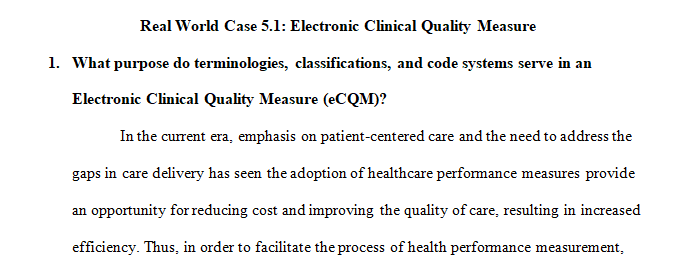Determine which clinical terminologies, classifications, and code systems would be used to capture the content.
Determine which clinical terminologies, classifications, and code systems would be used to capture the content.
- Discussion 5.1: Code Systems and Collecting Data [2c, 2d]
- Dropbox 5.1: Lab Assignment 5.1 -99 Differentials [2c, 2d]
- SPC Real World Case 5.1: Electronic Clinical Quality Measure (eCQM) [2c, 2d]
- SPC Real World Case 5.2: SNOMED and Smoking [2c, 2d ]
| Code Systems and Collecting Data15 POINTS |
Code Systems are utilized in collecting data in Healthcare documentation.
For this discussion, read Chapter 5 and research the internet to gather information.
You will then summarize the following information about Code Systems:
- Which code systems are used for Primary Data Collection?
- Which code systems are used for Secondary Data Collection?
| Guidelines |
Please make sure your discussion posts include all of the items below:
- Which code systems are used for Primary Data Collection?
- Which code systems are used for Secondary Data Collection?
- Note: your initial summary posts should be one or two paragraphs in length (a paragraph is at least 3 sentences in length).
- Reply to at least one classmate’s posts with a substantial thought.
- You must post first before you will be able to view those of your classmates.
| Lab Assignment 5.1: 99 Differentials15 POINTS |
View the following video: “99 Differentials” (4:24 YouTube)
https://youtu.be/TnkvLtJitvA
After viewing the video, answer the following questions in a one-page summary form:
- Identify the medical content mentioned in the video.
- Determine which clinical terminologies, classifications, and code systems would be used to capture the content.
| Guidelines |
Make sure your summary includes the items below:
- Identify the medical content mentioned in the video.
- Determine which clinical terminologies, classifications, and code systems would be used to capture the content
Module 5.1 Dropbox.SPC Real World Case 5.1Quiz
| Real World Case 5.1: Electronic Clinical Quality Measure (eCQM)20 POINTS |
For this activity, you will review the Real World Case 5.1. Conduct an analysis of the situation and summarize how you would have addressed the issues by answering the questions below.
Analyze Real World Case 5.1:Clinical quality measure developers create evidence-based standards used to assess the performance of providers in the provision of care. Developers include government agencies, accreditation organizations, and physician specialty groups among others. They select terminologies, classifications, and code sets as a way to express healthcare performance data used in the measure. For example, the National Committee for Quality Assurance (NCQA) may want to author an electronic Clinical Quality Measure (eCQM) for breast cancer screening. Using the web-based Measure Authoring Tool (MAT), NCQA decides to include mammograms as a population criterion. Having identified mammogram as one of the criteria, NCQA determines LOINC and HCPCS are necessary for the measure. Mammogram codes from these two systems are then selected to create the content for the breast cancer screening eCQM.Read the case study above and then answer the following questions:
- What purpose do terminologies, classifications, and code systems serve in an electronic Clinical Quality Measure (eCQM)?
- Why would NCQA choose LOINC and HCPCS for the electronic Clinical Quality Measure (eCQM) for breast cancer screening?
| Guidelines |
Before you submit your Real-World Case Study written responses:
- Ensure all of the Real World Case Study 5.1 questions are answered thoroughly.
View the Critical Thinking Assignment Rubric (20 points) for the grading criteria.
| Real World Case 5.220 POINTS |
For this activity, you will review the Real World Case 5.2:The 2015 Edition EHR technology certification criteria states the following:Smoking status: Enable a user to electronically record, change, and access the smoking status of a patient in accordance with the standard specified.45 CFR 170.315(a)(11).Coded to one of the following SNOMED CT codes:o Current every day smoker. 449868002o Current some day smoker. 428041000124106o Former smoker. 8517006o Never smoker. 266919005o Smoker, current status unknown. 77176002o Unknown if ever smoked. 266927001o Heavy tobacco smoker. 428071000124103o Light tobacco smoker. 428061000124105Objective: Record smoking status for patients 13 years or older.Measure: More than 85 percent of all unique patients 13-years-old or older seen by the eligible professional or admitted to the eligible hospital’s or critical care hospital’s inpatient or emergency department during the EHR reporting period have smoking status records as structured data.Included in the National Learning Consortium’s resources is a quick reference guide from the American Academy of Family Physicians (AAFP) for meeting the smoking status Meaningful Use requirement. The AAFP supports the incorporation of tobacco cessation into EHR templates (AAFP n.d.). The quick reference provides guidance on what should be included in a tobacco cessation EHR template.
Read the case study above and then answer the following questions.
- Why would SNOMED CT be used to record the smoking status of a patient on an EHR template?
- Why was ICD-10-CM not chosen as the system to capture smoking status?
| Guidelines |
Before you submit your Real-World Case Study written responses:
- Ensure all of the Real World Case Study 5.2 questions are answered thoroughly.
- View the Critical Thinking Assignment Rubric (20 points) for the grading criteria.
- Your summary should be in at least one page in length.
- The questions should be answered with detailed response
Requirements: 1-1.5 pages each
Answer preview for he paper on ‘Determine which clinical terminologies, classifications, and code systems would be used to capture the content’

APA 205 words
Click the purchase button below to download full answer…….
